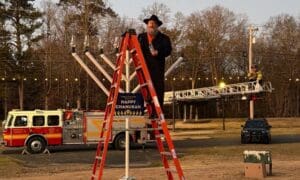“If we had known things were going to hit as hard and fast, if I had had that crystal ball, I would have obviously made a different decision. Knowing what I knew, based on the information I had, I felt like we were going to be OK.” — Dr. Joseph Barrow
Fayette County school students went to school Tuesday morning, Jan. 28, just like every other school day. After a mid-day snowfall covered roads in icy patches, many of them didn’t make it back home until well after dark. Parents were both anxious and furious.
Why officials made the decision to keep schools open in the face of a winter storm warning is the subject on the minds of many parents and taxpayers this week. On Friday, Superintendent Dr. Joseph Barrow took full responsibility for the call to close schools Tuesday afternoon and explained his reasoning.
“Like everyone else we were in tune with the reports as they were coming out. We were very much in touch with all our agencies, emergency management, the county, the cities and the National Weather Service. (The county) has an emergency operations center where we come together and have briefings. As late as Monday afternoon, and part of the reason whey we had school at all on Tuesday, all of our data on what was happening for Fayette, we felt like we were going to be okay in getting in a full day of school,” Barrow said.
“We had a 9 a.m. meeting on Tuesday to get an update. We felt like we were going to get flurries in the afternoon or maybe even as early as noon but it would be dry snow. The projections for the amount were relatively low. So we thought by the time school ended we would pretty much be within a window where we felt safe. Based on the 9 a.m. meeting we decided to release the schools about 30 minutes early. We felt like that would not be a big issue for the schools and not a big issue for parents and providers (by giving them) a little bit of lead time. We did not make the decision in isolation. We listened to all the information sources we had at our disposal. We’re all talking together and everybody was pretty much on the same page. Nobody voiced any reservations about having school.”
Fayette County EMA Director Pete Nelms agreed, saying that the consensus at the 9 a.m. meeting was that the school system would be able to get the full school day in and that the situation would be continuously monitored.
“If we couldn’t have gotten the (school) day in based on the information we had, we would have recommended calling it,” Nelms said, adding that there was constant communication throughout the day between his office and the school system.
Commenting further on the 9 a.m. meeting, Barrow said, “(The storm forecast) really hadn’t shifted much from Monday afternoon to the Tuesday morning report. Those reports are pretty sophisticated, but I also know those reports are not a 100 percent exact science. If you close schools or have an early release you’re going to make some people mad, and if you don’t close schools you’re going to make some people mad. I understand this and I appreciate the significance and the seriousness of the ramifications of our decisions. And we wrestle with those. But at the end of the day, when all is said and done, it’s not the fault of the board of education, it’s not the fault of the central office staff or the principals. It’s my decision and I assume full responsibility for that. I don’t try to sugar-coat it. It was my decision, and for those who want to issue criticism I’m willing to accept it. I own it completely.”
Barrow said he was in a community meeting with groups such as the NAACP and the district attorney when phones began ringing just before noon. It was during that time that snow began to fall and temperatures continued to drop.
“When it became apparent to us that it was going to hit us quicker and harder, we started modifying our plan. One of the first ones that we communicated with were all the high school principals to allow our student drivers to be released at 1:30 p.m. We were thinking we’d still be okay, but to let those inexperienced drivers leave because you want to use caution there,” Barrow said, adding that schools were told to let students leave 30 minutes early.
With snow and temperatures continuing to fall, the call was made to move up the release time to 1:30 p.m. for all schools. Principals were also notified that if they had employees who lived out of county that, while going through the process of early dismissal, they could let those employees go too, said Barrow.
“In the interim some parents (with children at elementary, middle and high schools) decided to go ahead and check out their students, which was fine,” said Barrow. “The traffic began to pick up at that point. We had done what we hoped to do, getting most of the day in. We were past that lunch time, our kids had been fed. That’s a concern for us. Some of our (students), if they don’t get fed at school they don’t eat. So there are a myriad of issues we look at when we’re talking about closing schools.”
Pay from the state requires approximately a half day of school, depending on a school’s start time. Asked if the decision was made to get in a half day of school so the school system could receive pay for the day, Barrow said, “Absolutely not. We value and treasure instructional time. That’s critically important to us. We don’t want to waste it and we don’t like messing with it and we were trying to get as much instructional time in as we could. If we had known things were going to hit as hard and fast, if I had had that crystal ball I would have obviously made a different decision. Knowing what I knew based on the information I had, I felt like we were going to be okay. Everybody is entitled to their opinion on things.”
“We had our last bus report in by 6:55 p.m.,” Barrow said of the final students being dropped off at home. “Part of the issue was due to road conditions. (Another part of the issue) was that parents coming from Atlanta couldn’t get to us. So we were holding some of the kids in our after school programs.”
Another issue that arose dealt with the north section of Peachtree Parkway being closed due to icing.
“It did throw a wrench in the gears. It affected buses from Crabapple, Kedron and Peachtree City elementary schools, and that impacts the buses at McIntosh and Booth,” said Barrow. “That created a problem for us. We were able to continue to deliver the kids that we could and thankfully they were able to open (Peachtree Parkway) back up. We dodged a big bullet there.”
Pertaining to the early release on Tuesday, Barrow said, “A huge tip of the hat goes to all our transportation people. They really stepped up. We had some folks running routes they don’t normally run because of the (weather conditions) we had.”
Barrow noting the efforts of the bus drivers on Tuesday said, “All the drivers were on alert. We put out the call and they responded. I can’t say anything but great things about our drivers, the transportation department and the people in central office.”
Barrow said that while this was his first winter storm with icy roads, he had previously dealt with the decision to close schools for issues such as flooding and the largest wildfire in the state that lasted a month.
“The circumstances (with a winter storm) are a little different, but the process (of determining to close schools) is very similar because there are a number of variables (such as weather reports) that have to be considered,” Barrow said.
Fayette schools ran 178 buses on Tuesday, driving a total of 21,000 miles. There was one accident involving a school bus when a car skidded into it after students had been dropped off at home. The driver of the vehicle that slid into the bus was charged with DUI alcohol, said Deputy Superintendent San Sweat.
“We’re going to learn from this experience, and we’re going to sharpen the saw and get better at it. When we get it right, we look pretty smart. And when we get it wrong, we look pretty silly,” Barrow said. “But there’s a variable out there called Mother Nature and we don’t control her. We can sometimes predict what we think will happen. And we’ll learn from the experience.”
Bus drivers on Friday drove their routes with empty buses to plot where “danger zones” existed or had existed on Tuesday so that those areas can be avoided during future winter storms by routing buses along different roadways. There were still icy patches on some of the roadways, according to transportation director Roxane Owen. Drivers who called in on the systemwide radio network reporting those icy areas were told to plot them but to avoid them, Owen said.












Leave a Comment
You must be logged in to post a comment.